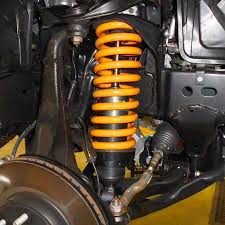
30 Jan Memorabilia: Coil Springs
FMM Assistant Curator Cheslynne Ruiters gets wound up and springs into New Year action …
In my last article in the November newsletter the topic was leaf springs, and this month I am really getting wound up looking at coil springs. These are considered by some as a step up from the leaf variety, but while many vehicles have suspension systems that combine leaf and coil springs, the latter are not ordinarily preferred for very heavy vehicles, as the coil-on-axle set-up is not as stable or strong as a proper leaf spring. Despite being expensive to retrofit into a vehicle, coil springs are less costly to produce and are mostly found in light vehicles. Additionally, coil springs are more compact and less prone to friction.
In 1763, a British inventor, R Tradewell, patented the first coil spring, number 792, and in 1857, the first-ever steel coil spring was invented, which was used for armchairs. The word coil means ‘to wind cylindrically or spirally’. By definition, a coil spring is a mechanical device that is typically used to store energy and subsequently release it, to absorb shock, or maintain a force between contacting surfaces.
Leaf springs suspensions are much simpler in terms of functionality as the axle is suspended by the spring, and does not require the arduous suspension geometry of the coil spring set-up. On the other hand, coil spring suspensions offer a greater range of suspension movement, and allow the user a wider tuning envelope through the suspension range than leaf springs.
Automotive road springs are highly stressed components. Their position underneath the car means they operate in a particularly aggressive environment. Road debris, small stones and grit thrown up by the tyre strike the exposed spring with such force that the surface coating may become damaged, revealing bare steel that can rust. Then cracks will grow every time the vehicle rides over a bump. In wet conditions, water mixes with the debris, which can remove the protective coating from the spring. That is why many automotive road springs, even those on relatively new vehicles, have some rust on the bottom coil. As winter arrives, the situation worsens when cold temperatures affect the toughness of the steel.
Coil springs can last the lifetime of the vehicle, but sometimes need to be changed. A good lamp will be required to check the lower condition of the coil where it sits in the spring pan, but never look for cracks or fractures by feeling with your fingers as the forces between the spring and the spring pan can be very high. Remove any road debris from the lower pan because this will help prevent premature failure. Springs that show any serious sign of corrosion should be replaced because they might fail at any time.



